Ukraine 2002 "Weapons of Victory"
| <prev | back to index | next> |
| Issue Date | 06.12.2022 |
| ID | Michel: Scott: |
| Design | Serhiy and Oleksandr Haruka |
| Stamps in set | 6 |
| Value |
U+3 - "Vilkha" U+3 - "Neptune" U+3 - "Stugna-P" U+3 - "Bayraktar TB2" U+3 - "Javelin" U+3 - "HIMARS" "U" = 12 Hrivna = domestic letter up to 50gr. rate. Additional 3 Hrivna is donation for the Ukrainian Army. |
| Emmision | commmemorative, semi-postal |
| Size (width x height) | stamps: 40.6mm x 26mm Mini-Sheet: 97mm x 129mm |
| Layout | Mini-Sheet of 6 |
| Products | FDC x1, PC x1 |
| Paper | |
| Perforation | |
| Print Technique | Offset lithography |
| Printed by | Integrated Printing Plant Ukraina For Securities |
| Quantity | 200,000 |
| Issuing Authority | Ukrposhta |
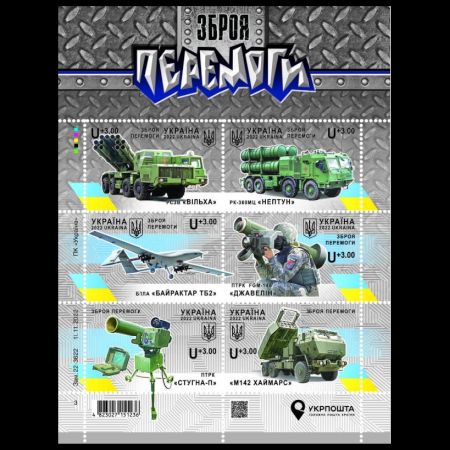
On December 6th, 2022, on the Day of the Armed Forces of Ukraine, the Post Authority of Ukraine - Ukrposhta - issued a set of 6 commemorative stamps - "Weapons of Victory".
All stamps have the same face value of "U+3".
"U" is the letter equivalent of domestic letter up to 50gr. rate. At the date of the issue, it was equivalent to 12 Ukrainian Hryvni (€0.30). Additional 3 Hryvni is donation to the Armed Forces of Ukraine.
From the first days of the full-scale war, the Armed Forces of Ukraine have been using weapons of both domestic and foreign production on the battlefield, which in the hands of Ukrainian soldiers every day brings Ukraine closer to victory. [R1]
"Vilkha" [R2] (Ukrainian: «Вільха», "Alder tree") is a Ukrainian heavy multiple rocket launcher system (MLRS) that fires guided missiles.
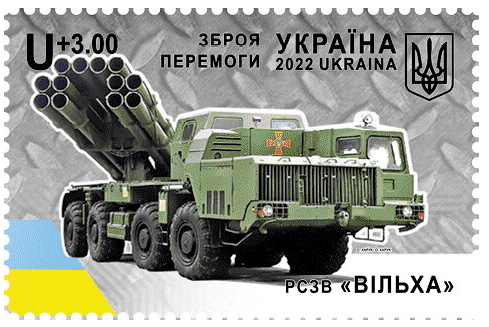
|
| Ukrainian MRLS Vilkha on stamp of Ukraine 2022 MiNr.: , Scott: |
The MLRS was test-fired several times in 2018, while the tests were also conducted at a military training ground in the Odesa region of Ukraine in August 2019. The Vilkha has been seen being used by Ukrainian Ground Forces during the 2022 Russian Invasion of Ukraine.
The MLRS can destroy infantry, armoured, and soft-skinned targets in concentration areas of artillery batteries, command posts, and ammunition depots. It is expected that in the near future Ukraine will complete the development of a new generation ballistic missile variant fired from the Vilkha-M complex, with the ability to hit targets at a distance of 200 km or more.
The MLRS has a crew of four and can fire all twelve missiles of caliber 300mm in 45 seconds. Maximum range: 70 km Vilkha, 130 km Vilkha-M, 141 km Vilkha-M2 (currently in development) with accuracy of 10-30 meters. The claimed truck speed is 100 km/h using a turbocharged diesel YaMZ-7511.10 engine. The rockets that it fires are claimed to have micromotors that boost the range of the rocket and also keep it stable in flight.
R-360 "Neptune" [R3] (Ukrainian: Р-360 «Нептун», romanized: R-360 "Neptun") is a Ukrainian anti-ship cruise missile developed by the State Kyiv Design Bureau “Luch” (the same Bureau who developed the MRLS "Vilkha").
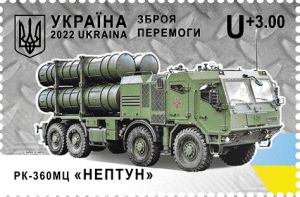
|
| R-360 Neptune anti-ship missile on stamp of Ukraine 2022 MiNr.: , Scott: |
The missile was first revealed at the 2015 Arms and Security international exhibition in Kyiv. In mid-2017, Neptune missiles were tested concurrently with Vilkha launchers and missiles. However, unlike the Vilkha, the test results and capabilities of the Neptune were not made public. According to the press service of the National Security and Defense Council of Ukraine, the first successful flight tests of the system took place on 30 January 2018. The first training missile divizion entered service with the Ukrainian Navy in March 2021.
On 13 April 2022, Ukrainian sources claimed the Russian cruiser Moskva was hit by two Neptune missiles, resulting in a fire and subsequent explosion of a shipboard ammunition store.
Moskva is one of the two largest warships to be sunk in combat since World War II. The successful use of the Neptune system to sink the warship was cited by Ukrainian Defence Minister Oleksii Reznikov as giving confidence to Ukraine's allies that more weapon supplies to Ukraine would be worth it.
A Neptune missile including rocket motor is 5.05 metres in length, with a cross-shaped hard wing. Neptune missiles are designed to be housed in transport and launch containers (TLC) with dimensions 5.30 by 0.60 by 0.60 metres. The system has a maximum range of about 300 kilometres.
A typical Neptun coastal defense battery consists of 6 launcher vehicles with a total of 24 anti-ship missiles. Launcher vehicles can be located up to 25 km from the sea. It takes 15 minutes to prepare this coastal defense missile system for firing.
"Stugna-P" [R4] (Ukrainian: "
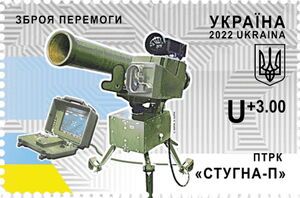
|
| Stugna-P anti-tank guided missile on stamp of Ukraine 2022 MiNr.: , Scott: |
Portable anti-tank missile system “Stugna-P” is designed to strike the manpower, movable and immovable modern armored targets with combined, spaced or monolithic armour including active armour, as well as pinpoint targets like permanent fire position, a tank in a trench, not heavily armoured objects and helicopters. The peculiarity of the complex is the ability to aim the missile on targets from the closed positions and holds, reducing the risk of destruction of gunner by the reverse firing of the enemy.
The Stugna-P is being used in the same way US forces used the TOW missile system in the 1980s and the Gulf War Desert Patrol Vehicle.
Kyiv ordered mass manufacture of the missile in March 2015, indicating that it would be useful in combating Russian and separatists in Eastern Ukraine after the 2014 annexation of Crimea and insurgency in the Donbas region.
On 25 April, near Izyum, during one engagement four tanks were destroyed or damaged in 4 minutes by the same Stugna-P operator.
"Bayraktar TB2" [R5] – unmanned aerial vehicle with a long flight duration (Turkey).
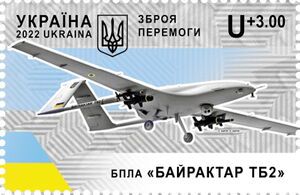
|
| Bayraktar TB2 unmanned aerial vehicle on stamp of Ukraine 2022 MiNr.: , Scott: |
By November 2021, the TB2 drone had completed 400,000 flight-hours globally. The largest operator of TB2 drones is the Turkish military, but an export model has been sold to the militaries of a number of other countries, including Ukraine.
As a part of its military modernization program the Armed Forces of Ukraine purchased 12 Bayraktar TB2s in 2019.
During the 2022 Russian invasion of Ukraine, TB2 drones have been used by Ukraine's armed forces against Russian forces and equipment. According to video footage released by the armed forces, TB2 drones have successfully destroyed on different occasions a Russian command post, military vehicles including tanks, IFVs, different types of trucks, surface-to-air missile systems (including Buk and Tor), self-propelled artillery, multiple rocket launcher (MLRS), howitzers and an electronic warfare system.
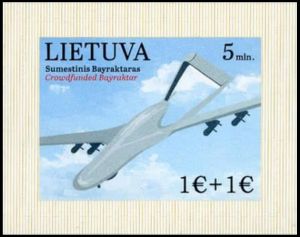
|
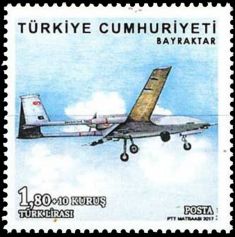
|
| Bayraktar TB2 unmanned aerial vehicle on semi-postal stamp of Lithuania 2022. MiNr.: , Scott: B56 | Bayraktar TB2 unmanned aerial vehicle on semi-postal stamp of Turkey 2017 MiNr.: 4389 , Scott: |
The popularity of the drone in Ukraine led to a song, "Bayraktar" being written about the drone while throwing insults at the Russian army and the invasion.
Several charity organizations in Ukraine and abroad, ran crowdfunding campaigns to collect money for Bayraktar drones for Ukrainian army. As part of such campaign, The Postal Authority of Lithuania issued a semi-postal stamp. The stamp has €1 postag and €1 charity values. The charity value was donated to the organization VšĮ "Mēlyna ir Geltona" ("Blue & Yellow"), who collected it to purchase a Bayraktar UCAV for Ukrainian Army.
On September 9th, 2022 Ukrainian President Volodymyr Zelenskiy met with the head of Turkish defence firm Baykar and said the company would set up a factory in Ukraine to build unmanned aerial vehicles.
FGM-148 "Javelin" [R6] – man-portable anti-tank missile system designed to destroy armoured vehicles, fortifications on the ground, as well as some aircraft (USA).
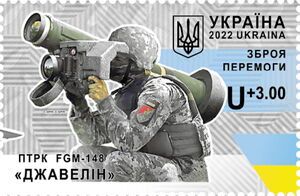 / /
|
| Javelin man-portable anti-tank missile system on stamp of Ukraine 2022 MiNr.: , Scott: |
Javelin is a fire-and-forget missile with lock-on before launch and automatic self-guidance. The system takes a top attack flight profile against armored vehicles, attacking the usually thinner top armor, but can also make a direct attack, for use against buildings, targets too close for top attack, targets under obstructions, and helicopters.
The missile is ejected from the launcher to a safe distance from the operator before the main rocket motors ignite – a "soft launch arrangement". This makes it harder to identify the launcher, though backblast from the launch tube still poses a hazard to nearby personnel. The firing team may move as soon as the "fire-and-forget" missile has been launched, or immediately prepare to fire on their next target.
During the 2022 Russian invasion of Ukraine, NATO provided thousands of Javelins to Ukraine, where they proved highly effective. Javelins have been responsible for a part of the hundreds of armored vehicles Ukraine has destroyed, captured or damaged.
M142 "HIMARS" [R7] – High Mobility Artillery Rocket System, which has in its arsenal guided high-precision rockets (USA).
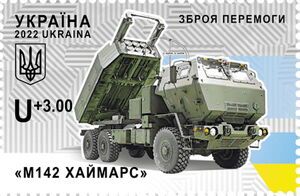
|
| High Mobility Artillery Rocket System - HIMARS on stamp of Ukraine 2022 MiNr.: , Scott: |
The HIMARS carries one pod with either six GMLRS rockets or one ATACMS missile. It is based on the United States Army's FMTV five-ton truck, and is capable of launching all rockets specified in the Multiple Launch Rocket System Family of Munitions (MFOM). HIMARS ammunition pods are interchangeable with the M270 MLRS; however, it is limited to a single pod as opposed to the standard two for the M270 and its variants.
The Ukrainian president Volodymyr Zelensky says that Himars missiles are changing the course of the war against Russia. The US-made system has been used to hit dozens of Russian targets such as command posts and ammunition depots. It has also been used to target bridges, including those on the approach to Russian-occupied Kherson. The missiles supplied to Ukraine have a range of up to 50 miles (80 km), which is over twice the range of the howitzer guns which the US has previously given to Ukraine. Himars can also fire a single Army Tactical Missile System missile, which has a range of 186 miles (300 km). However, the US isn't supplying Ukraine with these. The 50-mile range is roughly similar to that of Russian Smerch missiles, but Himars fires GPS-guided missiles which can be more accurately targeted.
Products
| FDC | Official Postcard | Postmarks [1] |
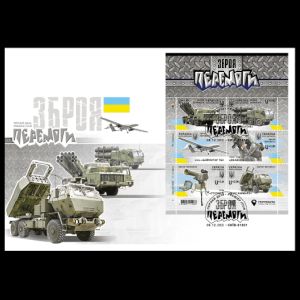 |
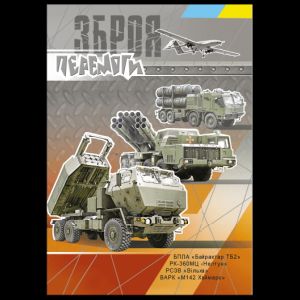 |
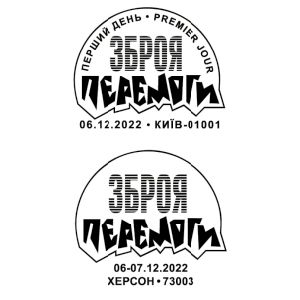 |
Notes:
[1] In addition to the official FDC postmark ("Premier Jour") of Kiev, additional postmarks with the similar design were available in more than two dozen of cities in Ukraine.

|
References
- [R1] Technical details and press release: Philatelic Newsletter of Ukrposhta, Ukrposhta, parlament.ua, english.nv.ua, Colnect.
- [R2] MLRS "Vilkha": Wikipedia, Army Technology.
- [R3] Anti-ship cruise missile "Neptune": Wikipedia, military-today.com.
- [R4] "Stugna-P" is a man-portable anti-tank missile system: Wikipedia, military-today.com, kaz.km.ua, eurasiantimes.
- [R5] Bayraktar TB2: Wikipedia, military-today.com, Forbes, Reuters.
- [R6] Advanced Anti-Tank Weapon System-Medium "Javelin": Wikipedia, Lockheed Martin.
- [R7] High Mobility Artillery Rocket System "HIMARS": Wikipedia, Lockheed Martin, military-today.com, BBC.
| <prev | back to index | next> |